Characterizing the Sediment-Hosted AurMac Reduced Intrusion-Related Gold Deposit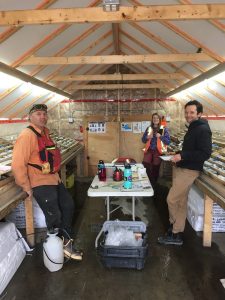
The AurMac Deposit, located in central Yukon, is a sediment-hosted interpreted reduced intrusion-related gold system (RIRGS) located hosting 7.0 Moz Au. The main objective of this study is to characterize the deposit in terms of its similarities to neighbouring mid-Cretaceous intrusion-hosted RIRGS through paragenetic relationships of mineralization, mineralization-related alteration, and absolute dating of mineralization events. Additionally, the bedrock geology and large-scale structure of the deposit will be studied along with targeting techniques for causative intrusions in sediment-hosted RIRGS. This project is being carried out in collaboration with Patrick Sack from the Yukon Geological Survey and James Thom from Banyan Gold. For more information on this project, contact Keagan Parry.
Mineralogy and geochemistry of structurally controlled nickel and cobalt in the Easter Duffy claim, East Arm NWT
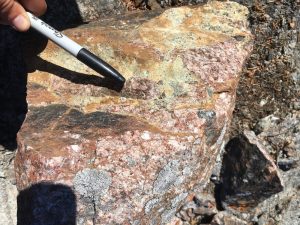
The Easter Duffy claim in the East Arm of the Great Slave Lake, NWT, is a structurally controlled nickel occurrence in a region where abundant cobalt and nickel occurrences with diverse mineralogy have been reported. The causes and controls for the diversity of minerals and their spatial distribution is a significant component of evaluating where they occur and their potential for extraction. This project aims to determine the mineralogy and paragenesis of cobalt and nickel in the Easter Duffy claim and evaluate the geochemical processes likely to have cause that mineralization. This project is being carried out in collaboration with Merilie Reynolds at the Northwest Territories Geological Survey and Hendrik Falck. For more information on this project, contact Cole Graham.
Characterizing fluids associated with alkalic porphyry systems
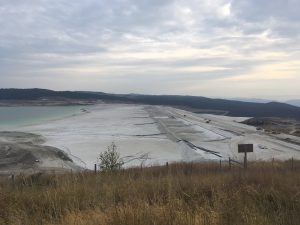
Porphyry deposits are one of the main sources of metals including copper and molybdenum. The recognition of alteration zonation in porphyry systems was one of the major breakthroughs in exploration for calc-alkalic porphyries. Knowing how alteration is distributed distally (up to a couple of kilometers above, below and laterally from the ore bodies) has allowed targeted drilling of mineral deposits at depths up to a kilometer below the surface. In contrast to calc-alkalic porphyries the patterns of alteration of alkalic porphyry deposits, which are abundant in BC, remains under-constrained, particularly in the porphyry to epithermal transition. This line of research aims to characterize the fluids responsible for alteration in alkalic porphyries and the geochemical processes that lead to the distinct geochemical and alteration characteristics in these systems in contrast to calc-alkalic porphyries. This project is being carried out in collaboration with Shaun Barker at University of British Columbia, a team of researchers from several universities in Canada, and several industry partners. For more information on this project, contact Maria Paula Estrella.
Linking mineralogy and fluid chemistry in the Yellowknife Greenstone Belt
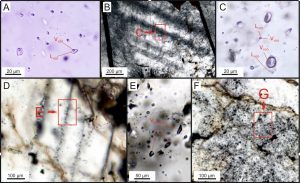
Mineralization in orogenic gold deposits is commonly associated with iron being extracted from the host rock and causing destabilization of gold bisulfide complexes during fluid-rock interaction. The reactions that liberate iron from the host rock can be observed in paragenetic studies. In parallel, specific fluid inclusion types are systematic associated with mineralized samples. Alteration reactions and fluid inclusion types related with gold have been established in prior projects for several claims of the Yellowknife Gold belt. This project aims to expand the applicability of the exploration models developed for individual claims, and evaluate the geochemical link between alteration mineralogy and fluid chemistry through geochemical modelling. This project is being carried out in collaboration with Merilie Reynolds at Northwest Territories Geological Survey and with Gold Terra Resource Corp. For more information in this project, contact Vivian Cho.
Characterizing the basement underlying metallogenic provinces in the MacKenzie Mountains
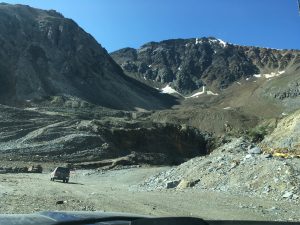
Melt source is one of the major controls proposed for tungsten metallogeny in the Hercynian deposits; however, the basement underlying the MacKenzie mountains and the source of magmas spatially associated with tungsten mineralization remains largely underconstrained due to a lack of exhumation. This study will use inherited zircon cores in granites spatially associated with tungsten mineralization to characterize the detrital age and composition of likely metasedimentary source(s) of fertile melts. Samples from plutons outcropping in the Tungsten belt previously collected by Kirsten Rasmussen, as well as additional sample materials collected for this work (as needed) will be studied. In each of the samples, zircons will be separated and mounted for SEM-CL mapping towards identifying inherited cores. Inherited cores will be analyzed in a split-stream LA-ICPMS system connected to two sector field mass spectrometers such that the Lu-Hf and U-Pb isotopic compositions of the cores can be determined in-situ simultaneously. The statistically significant populations of inherited U-Pb ages will be then compared to U-Pb isotopic datasets from the literature for detrital zircon populations within the MacKenzie mountains and presumed basement rocks exposed farther east to identify prospective magma and metal sources that likely underlie the Cordillera ( (e.g., Hadlari et al., 2012; Rainbird et al. 2017 ).Characterizing fluids associated with orogenic gold mineralization in the Yellowknife Greenstone Belt, NWT, Canada. For more information on this project, contact Kirsten Rasmussen.
